用了Linux 突然間想寫點(diǎn)C的程序,大家都說GTK 好用,所以就拿GTK 作實(shí)驗(yàn)。
第一步:搭建開發(fā)環(huán)境
1.gcc和java,這個(gè)應(yīng)該不難,一般的發(fā)行版里都有g(shù)cc,Java可以到www.sun.com下載,安裝配置,google 一下到處都是。
2.到www.netbeans.org 下載netbeans IDE ,有專門的C++ 版。
3.Gtk+可以直接安裝libgtk2.0-dev軟件包,也可以從http://www.gtk.org/下載源碼,編譯安裝。可能需要其他依賴的軟件包如下:
- pkg-config
- GNU make
- JPEG, PNG and TIFF image libraries
- FreeType
- fontconfig
- GNU libiconv library
- GNU gettext
- GLib
- Pango
- ATK
- GTK+
第二步:配置NetBeans
如果前三項(xiàng)都做完了,那么我們可以開始配置netbeans 了
1.啟動(dòng)netbeans ,打開工具->選項(xiàng)->C/C++
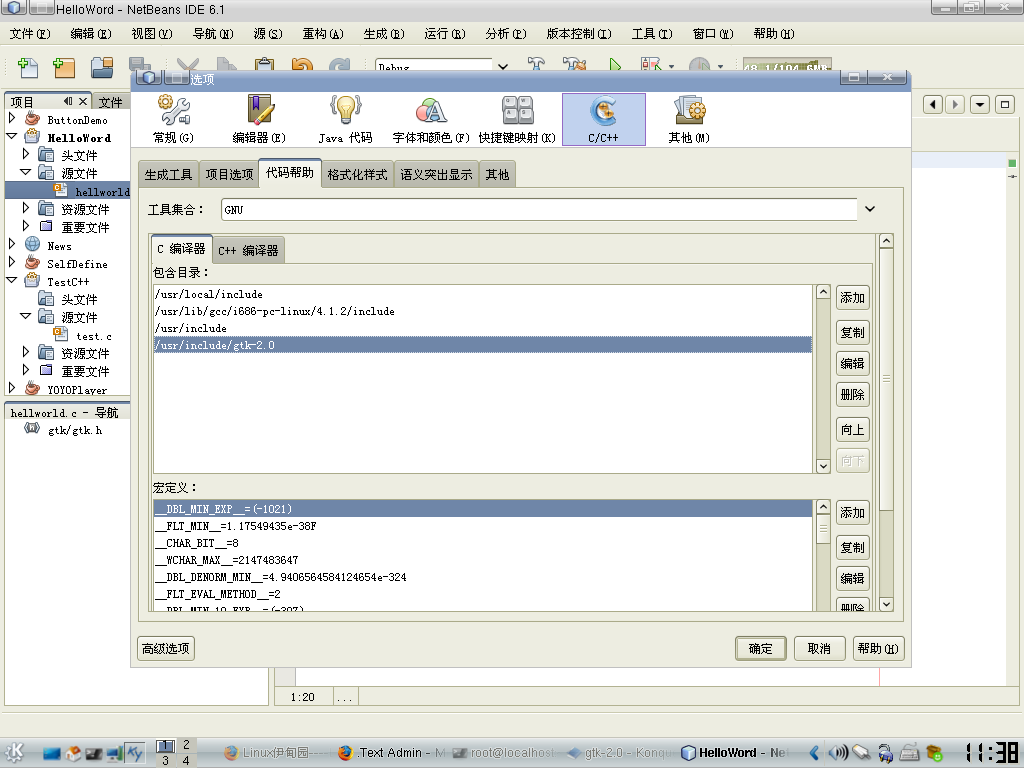
還有需要在項(xiàng)目屬性里添加如下路徑:
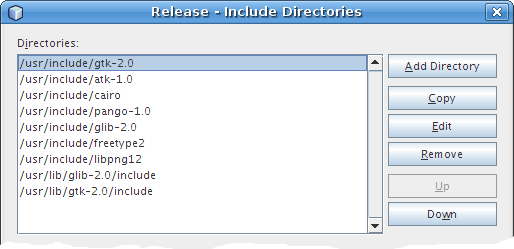
在代碼輔助里面添加GTK2.0的頭文件位置:
/usr/include/gtk-2.0
這是為了寫代碼的時(shí)候方便提示例如:
在沒有添加之前需要這樣寫:
#include<gtk-2.0/gtk/gtk.h>
添加之后就可以這樣寫:
#include<gtk/gtk.h>
接著我們就可以寫代碼了,這里我copy了一下網(wǎng)上的代碼:
#include<gtk/gtk.h>
/* This is a callback function. The data arguments are ignored
* in this example. More on callbacks below. */
static void hello( GtkWidget *widget,
gpointer data )
{
g_print ("Hello World\n");
}
static gboolean delete_event( GtkWidget *widget,
GdkEvent *event,
gpointer data )
{
/* If you return FALSE in the "delete_event" signal handler,
* GTK will emit the "destroy" signal. Returning TRUE means
* you don't want the window to be destroyed.
* This is useful for popping up 'are you sure you want to quit?'
* type dialogs. */
g_print ("delete event occurred\n");
/* Change TRUE to FALSE and the main window will be destroyed with
* a "delete_event". */
return TRUE;
}
/* Another callback */
static void destroy( GtkWidget *widget,
gpointer data )
{
gtk_main_quit ();
}
int main( int argc,
char *argv[] )
{
/* GtkWidget is the storage type for widgets */
GtkWidget *window;
GtkWidget *button;
/* This is called in all GTK applications. Arguments are parsed
* from the command line and are returned to the application. */
gtk_init (&argc, &argv);
/* create a new window */
window = gtk_window_new (GTK_WINDOW_TOPLEVEL);
/* When the window is given the "delete_event" signal (this is given
* by the window manager, usually by the "close" option, or on the
* titlebar), we ask it to call the delete_event () function
* as defined above. The data passed to the callback
* function is NULL and is ignored in the callback function. */
g_signal_connect (G_OBJECT (window), "delete_event",
G_CALLBACK (delete_event), NULL);
/* Here we connect the "destroy" event to a signal handler.
* This event occurs when we call gtk_widget_destroy() on the window,
* or if we return FALSE in the "delete_event" callback. */
g_signal_connect (G_OBJECT (window), "destroy",
G_CALLBACK (destroy), NULL);
/* Sets the border width of the window. */
gtk_container_set_border_width (GTK_CONTAINER (window), 50);
/* Creates a new button with the label "Hello World". */
button = gtk_button_new_with_label ("Hello World");
/* When the button receives the "clicked" signal, it will call the
* function hello() passing it NULL as its argument. The hello()
* function is defined above. */
g_signal_connect (G_OBJECT (button), "clicked",
G_CALLBACK (hello), NULL);
/* This will cause the window to be destroyed by calling
* gtk_widget_destroy(window) when "clicked". Again, the destroy
* signal could come from here, or the window manager. */
g_signal_connect_swapped (G_OBJECT (button), "clicked",
G_CALLBACK (gtk_widget_destroy),
G_OBJECT (window));
/* This packs the button into the window (a gtk container). */
gtk_container_add (GTK_CONTAINER (window), button);
/* The final step is to display this newly created widget. */
gtk_widget_show (button);
/* and the window */
gtk_widget_show (window);
/* All GTK applications must have a gtk_main(). Control ends here
* and waits for an event to occur (like a key press or
* mouse event). */
gtk_main ();
return 0;
}
NetBeans 的代碼提示:(借用別人的圖片)
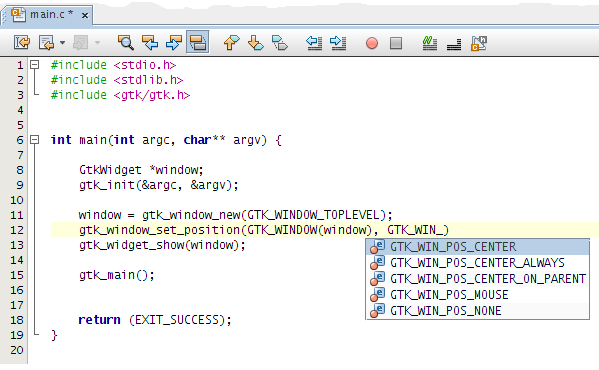
寫完代碼后試著運(yùn)行項(xiàng)目,你會(huì)發(fā)現(xiàn)出錯(cuò)了。解決辦法:
在項(xiàng)目的屬性C編譯器“命令行->其他選項(xiàng)”選項(xiàng)里添加一行命令行參數(shù)
`pkg-config gtk+-2.0 --cflags --libs`
他的意思是把運(yùn)行g(shù)tk 的依賴庫包含進(jìn)來。
注意:這兩個(gè) 符號(hào):` ` 不是我們常用的那個(gè)單引號(hào),而是Tab 鍵上面一個(gè)鍵的符號(hào)。
最后的結(jié)果截圖:
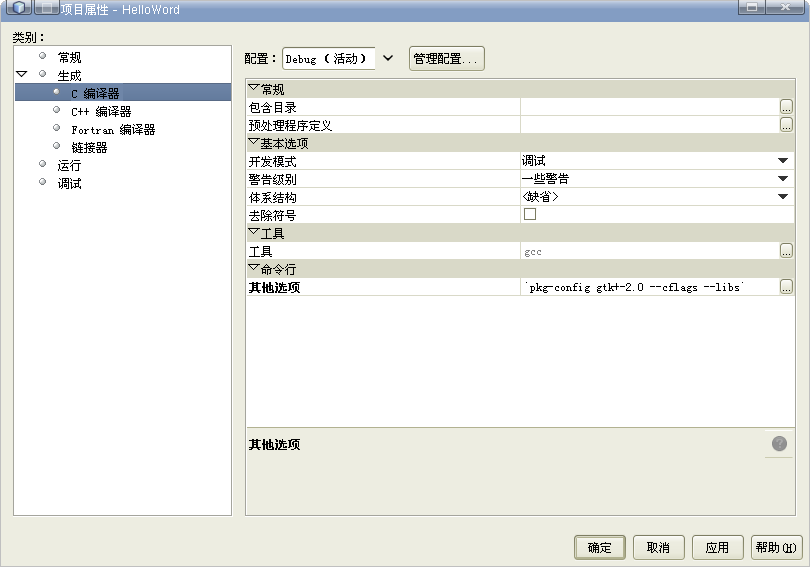
做完以上工作以后再次運(yùn)行項(xiàng)目,是不是成功了!
運(yùn)行結(jié)果:
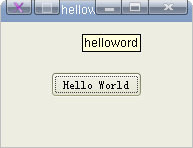
順便推薦幾篇blog 給大家
http://blog.chinaunix.net/u1/48222/showart_393772.html
強(qiáng)烈推薦這篇博客,雖然他是英文的
http://zetcode.com/articles/netbeanscdevelopment/